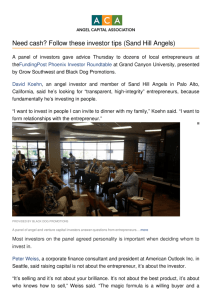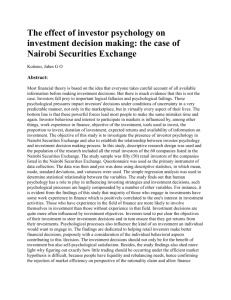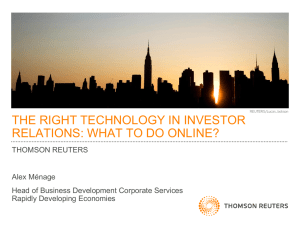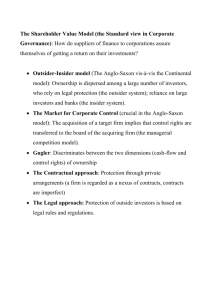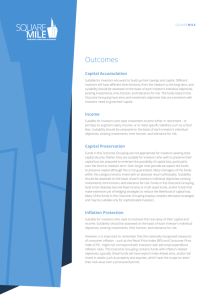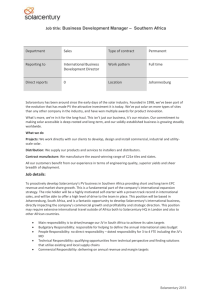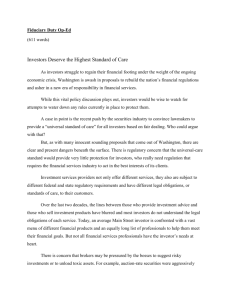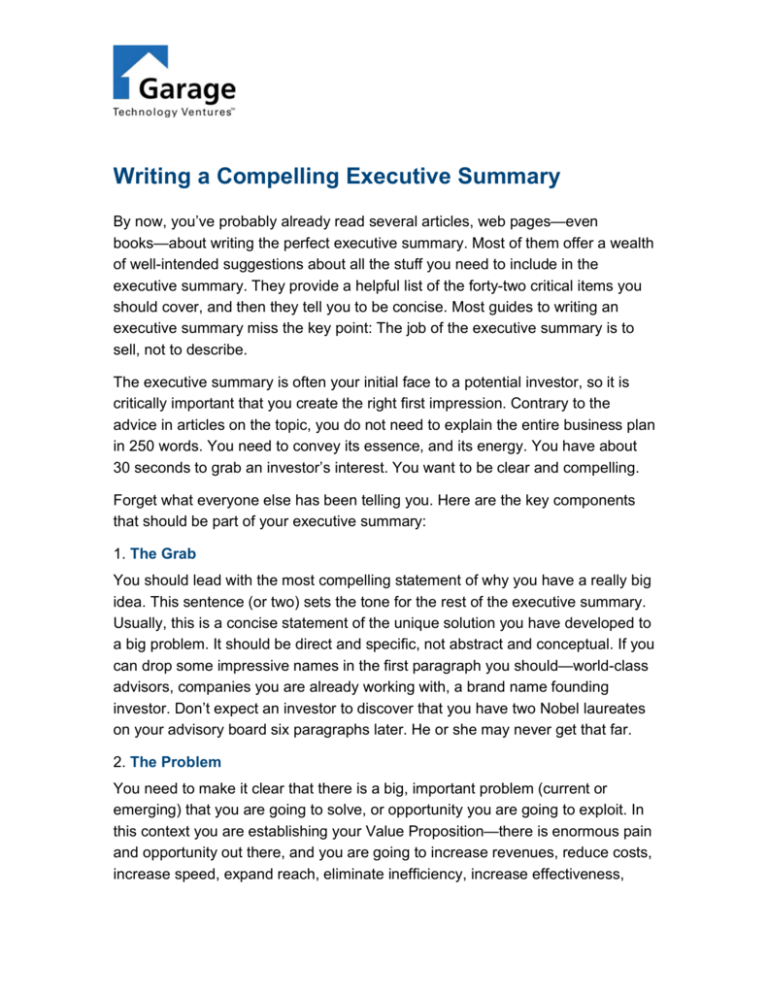
Writing a Compelling Executive Summary
By now, you’ve probably already read several articles, web pages—even
books—about writing the perfect executive summary. Most of them offer a wealth
of well-intended suggestions about all the stuff you need to include in the
executive summary. They provide a helpful list of the forty-two critical items you
should cover, and then they tell you to be concise. Most guides to writing an
executive summary miss the key point: The job of the executive summary is to
sell, not to describe.
The executive summary is often your initial face to a potential investor, so it is
critically important that you create the right first impression. Contrary to the
advice in articles on the topic, you do not need to explain the entire business plan
in 250 words. You need to convey its essence, and its energy. You have about
30 seconds to grab an investor’s interest. You want to be clear and compelling.
Forget what everyone else has been telling you. Here are the key components
that should be part of your executive summary:
1. The Grab
You should lead with the most compelling statement of why you have a really big
idea. This sentence (or two) sets the tone for the rest of the executive summary.
Usually, this is a concise statement of the unique solution you have developed to
a big problem. It should be direct and specific, not abstract and conceptual. If you
can drop some impressive names in the first paragraph you should—world-class
advisors, companies you are already working with, a brand name founding
investor. Don’t expect an investor to discover that you have two Nobel laureates
on your advisory board six paragraphs later. He or she may never get that far.
2. The Problem
You need to make it clear that there is a big, important problem (current or
emerging) that you are going to solve, or opportunity you are going to exploit. In
this context you are establishing your Value Proposition—there is enormous pain
and opportunity out there, and you are going to increase revenues, reduce costs,
increase speed, expand reach, eliminate inefficiency, increase effectiveness,
whatever. Don’t confuse your statement of the problem with the size of the
opportunity (see below).
3. The Solution
What specifically are you offering to whom? Software, hardware, service,
combination? Use commonly used terms to state concretely what you have, or
what you do, that solves the problem you’ve identified. Avoid acronyms and don’t
try to use these precious few words to create and trademark a bunch of terms
that won’t mean anything to most people. You might need to clarify where you fit
in the value chain or distribution channels—who do you work with in the
ecosystem of your sector, and why will they be eager to work with you. If you
have customers and revenues, make it clear. If not, tell the investor when you
will.
4. The Opportunity
Spend a few more sentences providing the basic market segmentation, size,
growth and dynamics—how many people or companies, how many dollars, how
fast the growth, and what is driving the segment. You will be better off targeting a
meaningful percentage of a smaller, well-defined, growing market than claiming a
microscopic percentage of a huge, heterogeneous, mature market. Don’t claim
you are addressing the $24 billion widget market, when you are really addressing
the $85 million market for specialized arc-widgets used in the emerging wocket
sector.
5. Your Competitive Advantage
No matter what you might think, you have competition. At a minimum, you
compete with the current way of doing business. Most likely, there is a near
competitor, or a direct competitor that is about to emerge (are you sufficiently
paranoid yet??). So, understand what your real, sustainable competitive
advantage is, and state it clearly. Do not try to convince investors that your key
competitive asset is your “first mover advantage.” Here is where you can
articulate your unique benefits and advantages. Believe it or not, in most cases,
you should be able to make this point in one or two sentences.
6. The Model
How specifically are you going to generate revenues, and from whom? Why is
your model leverageable and scaleable? Why will it be capital efficient? What are
the critical metrics on which you will be evaluated—customers, licenses, units,
Page 2
revenues, margin? Whatever it is, what impressive levels will you reach within
three to five years?
7. The Team
Why is your team uniquely qualified to win? Don’t tell us you have 48 combined
years of expertise in widget development; tell us your CTO was the lead widget
developer for Intel, and she was on the original IEEE standards committee for
arc-widgets. Don’t just regurgitate a shortened form of each founder’s resume;
explain why the background of each team member fits. If you can, state the
names of brand name companies your team has worked for. Don’t drop a name if
it’s an unknown name, and don’t drop a name if you aren’t happy to give the
contact as a reference at a later date.
8. The Promise
When you are pitching to investors, your fundamental promise is that you are
going to make them a boatload of money. The only way you can do that is if you
can achieve a level of success that far exceeds the capital required to do that.
Your Summary Financial Projections should clearly show that. But if they are not
believable, then all of your work is for naught. You should show five years of
revenues, expenses, losses/profits, cash and headcount. You should also show
a key driver or two, such as number of customers and units shipped each year.
9. The Ask
This is the amount of funding you are asking for now. This should generally be
the minimum amount of equity you need to reach the next major milestone. You
can always take more if investors are willing to make more available, but it is
hard to take less. If you expect to be raising another round of financing later,
make that clear, and state the expected amount.
You should be able to do all this in six to eight paragraphs, possibly a few more if
there is a particular point that needs emphasis. You should be able to make each
point in just two or three simple, clear, specific sentences.
This means your executive summary should be about two pages, maybe three.
Some people say it should be one page. They’re wrong. (The only reason
investors ask for one page summaries is that they are usually so bad the
investors just want the suffering to be over sooner.) Most investors find that there
is not enough information in one page to understand and evaluate a company.
Page 3
Please remember that the outline above should not be applied rigidly or
religiously. There is no template that fits all companies, but make sure you touch
in each key issue. You need to think through what points are most important in
your particular case, what points are irrelevant, what points need emphasis, and
what points require no elaboration.
Some other general points:
!
Do not lead with broad, sweeping statements about the market
opportunity. What matters is not market size, but rather compelling pain.
Investors would rather invest in a company solving a desperate problem
for a small growing market, than a company providing an incremental
improvement for a large established market.
!
Don’t acronym your own name. Sun Microsystems did not build its brand
by calling itself “SMI.” (Of course, if you know where the name Sun came
from, you understand this is an inside joke.)
!
Drop names, if they are real; don’t drop names if they are smoke. If you
have a real partnership with a brand name company, don’t hide your
lantern under a bushel basket. If you consulted for Cisco’s HR department
one week, don’t say you worked for Cisco.
!
Avoid “purple farts”—phrases and adjectives that sound impressive but
carry no substance. “Next generation” and “dynamic” probably don’t mean
anything to your readers (unless you are talking about DRAM) and tend to
be irritating. Everybody thinks their software is “intelligent” and “easy-touse,” and everyone thinks their financial projections are “conservative.”
Explain your company the way you would to a friend at a cocktail party
(after one drink, not five).
!
State your value proposition and competitive advantage in positive terms,
not negative terms. It is what you can do that is important, not what others
cannot do. With the one or two most obvious competitors, however, you
may need to be very explicit: “Unlike Cisco’s firewall solution, our
software can operate...”
!
Use simple sentences, not multi-tiered compound sentences.
Page 4
!
Use analogies, as long as you are clarifying rather than hyping. You can
say you are using the Google model for generating revenues, as long as
you don’t say you expect to be the next Google.
!
Don’t lie. You would think this goes without saying, but too many
entrepreneurs cross over the line between passionate enthusiasm and
fraudulent misrepresentation. On a lighter note, check out “The Top Ten
Lies of Entrepreneurs” on the Garage website.
!
Go back and reread each sentence when you think you’re done: Is each
sentence clear, concise and compelling?
If you are looking for help developing your slide presentation for investors, you
can read “Perfecting Your Pitch” on the Garage website.
Finally, one of the most important sentences you write will not even be in the
executive summary—it is the sentence that introduces your company in the email
that you or a friend uses to send the executive summary. Your summary might
not even get read if this sentence is not well-crafted. Again, it should be specific
and compelling. It should sell your company, not just describe it.
Venture investors are predisposed to like entrepreneurs. Many of us were
entrepreneurs in our prior lives, and all of us enjoy the challenge and excitement
of starting up companies. We are on your side. So please help us get to know
you better by telling your story clearly and concisely.
Good luck!
If you have any questions about this article, or about Garage Technology
Ventures, you can contact Bill Reichert, Managing Director of Garage
Technology Ventures (email: reichert@garage.com).
© 2007 Garage Technology Ventures, LLC. All Rights Reserved
Page 5

